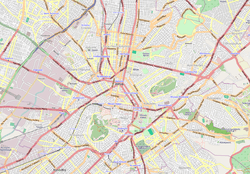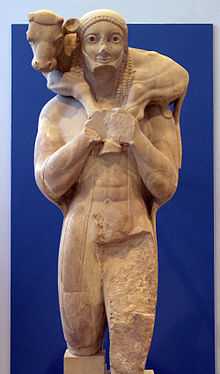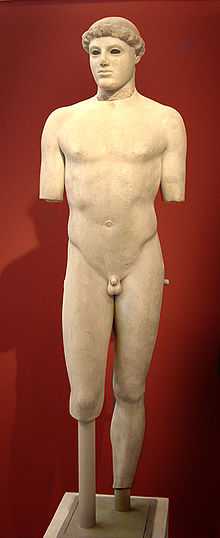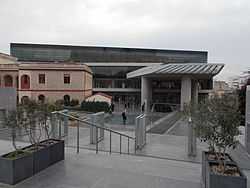Acropolis Museum
| Acropolis Museum | |
|---|---|
| Μουσείο Ακρόπολης | |
|
The entrance to the Acropolis Museum | |
 Location within Athens | |
| Established | June 20, 2009 [1] |
| Location |
Dionysiou Areopagitou Street Athens, Greece |
| Coordinates | 37°58′05″N 23°43′44″E / 37.968°N 23.729°E |
| Type | Archaeological Museum |
| Collection size | 4,250+ objects |
| Visitors | 1,036,059 (June 2012–June 2013)[2] |
| Director | Dimitrios Pandermalis |
| Owner | Hellenic Ministry of Culture and Tourism |
| Public transit access |
|
| Website | www.theacropolismuseum.gr |
The Acropolis Museum (Greek: Μουσείο Ακρόπολης, Mouseio Akropolis) is an archaeological museum focused on the findings of the archaeological site of the Acropolis of Athens. The museum was built to house every artifact found on the rock and on its feet, from the Greek Bronze Age to Roman and Byzantine Greece. It also lies on the archaeological site of Makrygianni and the ruins of a part of Roman and early Byzantine Athens.
The museum was founded in 2003, while the Organisation of the Museum was established in 2008. It opened to the public on June 20, 2009.[1] Nearly 4,000 objects are exhibited over an area of 14,000 square metres.The Organisation for the Construction of the new museum is chaired by Aristotle University of Thessaloniki Professor Emeritus of Archaeology, Dimitrios Pandermalis.
History
The first museum was on the Acropolis; it was completed in 1874 and underwent a moderate expansion in the 1950s. However, successive excavations on the Acropolis uncovered many new artifacts which significantly exceeded its original capacity.
An additional motivation for the construction of a new museum was that in the past, when Greece made requests for the return of the Parthenon Marbles from the United Kingdom, which acquired the items in a controversial manner, it was suggested by some British officials that Greece had no suitable location where they could be displayed. Creation of a gallery for the display of the Parthenon Marbles has been key to all recent proposals for the design of a new museum.
Competitions for the new museum


The first architectural competition to design a new museum was held in 1976 and was limited to participants from Greece. Both the 1976 competition and one that followed it in 1979 failed to produce any results mainly because the plots of land selected for the proposed constructions were deemed unsuitable.
In 1989, a third competition for the design of the new Acropolis Museum was announced that would be international. A choice of three possible sites was provided. This competition was won by the Italian architects, Manfredi Nicoletti and Lucio Passarelli. After delays throughout the 1990s, work on the construction of the museum based on this third design progressed to the stage of excavations for the foundations, but these were stopped due to apparently sensitive archaeological remains on the site, leading to annulment of the competition in 1999. In retrospect, the location of the new museum was rather straightforward: the large lot of the unused "Camp Makrygianni" gendarmerie barracks, opposite the Theater of Dionysus. The barracks were built on public land and a limited number of expropriations of surrounding private houses were needed to free up the necessary space. The main building of the old barracks, the neoclassical "Weiler Building", has been renovated and houses the Museum of the Center for the Acropolis Studies.
The fourth competition had made no provision for the preservation of the ancient site. These were met to a degree only after local and international (ICOMOS) campaigners exposed this oversight and it became the final competition. The new plans were adjusted so that the building was elevated above ground, on pillars. Competition was open only to architectural practices by invitation and it was won by New York–based architect, Bernard Tschumi, in collaboration with the Greek architect Michael Photiadis. Excavation has revealed two layers of modest, private roadside houses and workshops, one from the early Byzantine era and another from the classical era. Once the layout and stratigraphy of the findings were established, suitable locations for the foundation pillars were identified. These traverse the soil to the underlying bedrock and float on roller bearings able to withstand a Richter scale magnitude 10 earthquake.
As construction work neared completion, the operation to move the historic artifacts the 280-meter (310 yd) distance from the Acropolis rock to the new museum started in October 2007, took four months, and required the use of three tower cranes to move the sculptures across the distance without mishap. Greek officials expressed their hope that the new museum will help in the campaign for the return of the Parthenon Marbles.[3][4]
Location

The museum is located by the southeastern slope of the Acropolis hill, on the ancient road that led up to the "sacred rock" in classical times. Set only 280 meters (310 yd), away from the Parthenon, and a mere 400 meters (440 yd) walking distance from it, the museum will be the largest modern building erected so close to the ancient site, although many other buildings from the last 150 years are located closer to the Acropolis. The entrance to the building is on Dionysiou Areopagitou Street and directly adjacent to the Akropoli metro station, line 2 of the Athens Metro.
The building
.jpg)
The design by Bernard Tschumi was selected as the winning project in the fourth competition. Tschumi's design revolves around three concepts: light, movement, and a tectonic and programmatic element. Together these characteristics "turn the constraints of the site into an architectural opportunity, offering a simple and precise museum" with the mathematical and conceptual clarity of ancient Greek buildings.
The collections of the museum are exhibited on three levels while a fourth middle level houses the auxiliary spaces such as the museum shop, the café and the offices. On the first level of the museum there are the findings of the slopes of the Acropolis. The long and rectangular hall whose floor is sloping, resembles the ascension to the rock. Then, the visitor is found at the large trapezoidal hall which accommodates the archaic findings. On the same floor there are also the artifacts and sculptures from the other Acropolis buildings such as the Erechtheum, the Temple of Athena Nike and the Propylaea and findings from Roman and early Christian Athens. However the visitor is intended to see the latter during descent so as to keep the chronological order because he will first be directed to the top level, which displays the Parthenon marbles.
The top level of the Museum sits askew on the lower levels to achieve the same cardinal orientation as that of the ancient temple on the Acropolis. The spacing of the columns of the Parthenon hall is the same as that of the ancient temple, and the use of glass walls on all four exterior walls allows the natural light to illumine the Parthenon marbles as they do on the ancient temple. The 48 columns in the Parthenon hall mark the outline of the ancient temple and form a colonnade for the display of the Parthenon marbles. For ease of viewing, the pediment marbles are displayed at eye level in front of the end columns; the metopes are displayed on the columns, two per column, but not as high as in the ancient temple; and the frieze are displayed behind the metopes, forming a continuous band around the walls of a rectangular space set inside the columns, as in the ancient temple but not as high, again for ease of viewing. From the north side of the Parthenon hall, one can see the ancient temple above on the Acropolis.
As the museum is built over an extensive archaeological site, the floor, outside and inside, is often transparent using glass and thus the visitor can see the excavations below. The museum also provides an amphitheatre, a virtual theatre and a hall for temporary exhibitions.
Controversy
A controversy erupted over the plans of the new museum and whether it was appropriate to build it on the archaeological site in Makrygianni. Another concern was whether a large modern building would fit well into the landscape.[5]
In 2007, another controversy erupted over the proposed demolition of two historic buildings. These are in front of the museum, numbers 17 and 19, Dionysiou Areopagitou Street,[6] facing the Acropolis (see picture, left). Bernard Tschumi has been showing photographic images of the space in front of the museum edited to remove the two buildings and nearby four-story-tall trees. The Greek Government has had the two buildings de-listed historically although one is Neo-Classical[7] and the other an example of Art Deco architecture.[6][7] Protests against the proposed demolition came from international agencies such as INTBAU[6] and ICOMOS.[7]
At the centre of the controversy is the composer Vangelis Papathanassiou, who is the owner of the neo-classical house targeted for demolition. According to Greek officials the house obstructs the view to the ancient Theater of Dionysus, which is located on the southern slope of the Acropolis. Vangelis Papathanasiou claims that the real reason for the demolition plan to include his house is because it blocks the view from the museum restaurant, and he has accused the Greek government of “architectural terrorism”. The latest proposal with regard to the impasse is a planned salvage and transfer of the facades of these two buildings to adjacent, newer buildings; this will allow demolition while preserving the facades, albeit, out of context to their original locations.
Awards
- On 13 May 2010, it was awarded the International Association of Lighting Designers (IALD) Award of Excellence and Sustainability.[8]
- On 8 November 2010, the Museum won the British Guild of Travel Writers' (BGTW) award in Globe category for the Best Worldwide Tourism Project for 2010.[9]
- The Museum received 2011 AIA (The American Institute of Architects) Institute Honor Award for Architecture.[10][11]
- It was among the six finalists competing for the 2011 European Union Prize for Contemporary Architecture – the Mies van der Rohe Award.[12]
- On Friday 14 September 2012 the Acropolis Museum was awarded for its innovative program of the conservation and the restoration of the Caryatids by the International Institute for Conservation (IIC) in Vienna, with the Keck Award 2012.[13][14]
Other information
- The entrance fee to the museum was €1 for the first year and €5 thereafter.
- The excavation below ground level continues. The site and process are visible through the ground level glass flooring. The site will be available for visitation once the excavation is complete.
- The Acropolis Museum recently was selected as the motif for a commemorative Euro coin edition: the €10 Greek Acropolis Museum commemorative coin, minted in 2008 to mark the relocation of the museum. On the obverse is a panoramic view of the Acropolis and the new museum lies at the base.
- The recent years the Acropolis Museum, the night of the August full moon remains open until late the night and welcomes visitors for free.[15] Also the same night concerts take place on the museum's courtyard.[16]
- In the first two months since the museum opened, it was visited by 523,540 people (an average of 9,200 a day). Of these, 60 percent were foreign visitors. During the same two-month period, 409,000 hits by unique visitors from 180 countries were recorded by the museum’s website.[17]
- The University of Sydney’s Nicholson Museum, have donated (December 2014 - December 2015) to the Acropolis Museum a Lego Acropolis model. The model contains more than 120,000 Lego bricks and took about 300 hours to build by Ryan McNaught.[18][19]
Gallery
-

Horse (6th BC)
-

Moschophoros (560 BC)
-
Peplos Kore (c.530 BC)
-

Acropolis Kore (510 BC)
-
Detail of a Kore (530-520 BC)
-

Kritios boy (c.480 BC)
-
_2.jpg)
Caryatids of Erechtheum
-

Goddess Nike (1st to 3rd century AD)
-

Bust of Tiberius Julius Sauromates II
See also
- Museum of the Center for the Acropolis Studies, located in the adjacent Wilhelm von Weiler Building.
- Old Acropolis Museum, now closed and scheduled to house workshops for the ongoing Acropolis Restoration Project.
References
- ↑ 1.0 1.1 Wonderful Greece
- ↑ http://www.theacropolismuseum.gr/sites/default/files/acropolis_gr.pdf
- ↑ BBC News, Cranes move Acropolis sculptures, Retrieved on 2007-10-15.
- ↑ Athens Press Agency, Macedonian Press Agency, New Acropolis Museum to open in stages in 2008, Retrieved on 2008-10-18.
- ↑ Papathanasopoulos, G. (2002-11-12). "Aντιπαράθεση για το Nέο Mουσείο Aκρόπολης". Kathimerini (in Greek) (news.kathimerini.gr/) (Sunday November 10, 2002). Retrieved 2009-05-20.
- ↑ 6.0 6.1 6.2 "Acropolis Now: Call for help to save neoclassical architectural heritage of Athens". International Network for Traditional Building, Architecture and Urbanism (www.intbau.org). 2007. Retrieved 2008-12-17.
- ↑ 7.0 7.1 7.2 Campbell, Matthew (2007-11-18). "Vangelis Papathanassiou fights Greek gods of demolition". The Sunday Times (London: www.timesonline.co.uk). Retrieved 2007-11-23.
- ↑ http://www.iald.org/file.asp?c=awards\press&f=EB8F4AE1E7474B7CA5B8C155EC790C0D.pdf The International Association of Lighting Designers (IALD)"Accepting the IALD Award of Excellence and Sustainability Award for the NEW ACROPOLIS MUSEUM was Florence Lam and Vasiliki Malakasi of Arup Lighting. "
- ↑ http://www.bgtw.org/tourism-awards-winners-2010.html British Guild of Travel Writers "The winner of the Globe Category (receiving more than 250,000 visitors a year), nominated by Nigel Tisdall, was the new Acropolis Museum in Athens (www.newacropolismuseum.gr/eng), built to replace the old museum which has done an admirable job since 1865, but was short of space. "
- ↑ http://www.aia.org/aiaucmp/groups/aia/documents/html/aiab089705.html 2011 Recipients AIA Institute Honor Awards for Architecture
- ↑ http://www.youtube.com/watch?v=KfaKqoEzvwM
- ↑ http://ec.europa.eu/culture/our-programmes-and-actions/doc1103_en.htm European Union Prize for Contemporary Architecture / Mies van der Rohe Awards
- ↑ http://www.theacropolismuseum.gr/en/content/conserving-caryatids Acropolis Museum "The Acropolis Museum was awarded for this innovative program by the International Institute for Conservation (IIC) in Vienna, with the Keck Award 2012"
- ↑ http://www.theacropolismuseum.gr/sites/default/files/press_release_keck_award_2012_acropolis_museum.pdf press release keck award 2012 acropolis museum
- ↑ "Information about the August full moon in Acropolis Museum.".
- ↑ "Photos and videos of the Acropolis Museum during the night of August full moon 2013.".
- ↑ Visitation numbers published by Kathimerini
- ↑ "The Acropolis in Lego bricks and lots of fun!". http://www.theacropolismuseum.gr''.
- ↑ "Acropolis Museum receives Lego model from Nicholson Museum". http://www.welcometravel.gr''.
Bibliography
- Tschumi, Bernard; Pandermalis, Dimitrios; Aesopos, Yannis; Rutten, Joel (2009). The New Acropolis Museum. Skira Rizzoli. ISBN 978-0847834198.
- Tschumi, Bernard (2010). New Acropolis Museum. Ediciones Poligrafa. ISBN 978-8434312340.
External links
| Wikimedia Commons has media related to Acropolis New Museum Building. |
- Official site
- The Parthenon frieze.
- Color the Peplos Kore.
- Athena, Goddess of the Acropolis.
- Google Art Project.
- Acropolis Museum - Ebook by Latsis Foundation
- The New Acropolis by C. Sandis
- A visitors look at the Acropolis Museum
- Review of the Acropolis Museum at UNRV.com
Videos
- New Acropolis Museum Receives 2011 AIA Institute Honor Award for Architecture
- A short visit to the Acropolis Museum
- New Acropolis Museum, Athens - Opening Ceremony Video Projections
| ||||||||||||||||||||||||||||||||||
| ||||||||||||||||||||


